Last Updated on January 21, 2024 by Greg Gillson
Did you see a brightly-colored red bird, orange bird, or yellow bird in Nevada and wonder what it was?
This page is for you!
This article shows you photos and identification of some of the most common birds in Nevada based on color.
The list of birds found in Nevada includes over 480 species. So, I can’t show you all of them. I’m going to assume that you saw a common bird of this color, but you certainly could have seen something less common, or even rare!
Shape (including the shape of the bill) and size are often more helpful in starting to identify a bird than the color. In fact, most birds in North American can be easily identified with a black-and-white photo!
Many birds are multi-colored, so that it may be hard to pick out a dominant color. Males and females may be colored quite differently. And some color patterns are similar among otherwise dissimilar species.
Nevertheless, I’m going to try to pick out some of the birds that you are most likely to see in backyards or towns. And I’ll show a few others that I get asked about a lot.
The birds with a noticeable amount of red on them in Nevada covered in this article are:
- House Finch
- Cassin’s Finch
- Anna’s Hummingbird
- American Robin
The birds with a noticeable amount of orange on them in Nevada covered in this article are:
- Cinnamon Teal
- Northern Flicker
- American Kestrel
- Ruddy Duck
- Spotted Towhee
- Barn Swallow
- Bullock’s Oriole
- Black-headed Grosbeak
The birds with a noticeable amount of yellow on them, including lots of yellow and black birds, in Nevada covered in this article are:
- Lesser Goldfinch
- American Goldfinch
- Verdin
- Yellow-rumped Warbler
- Western Kingbird
- Western Meadowlark
- Yellow Warbler
- Yellow-headed Blackbird
- Western Tanager
- Common Yellowthroat
- Wilson’s Warbler
- MacGillivray’s Warbler
- Pine Siskin
- Cedar Waxwing
Red birds of Nevada
Birds get the red, orange, and yellow in their feathers from carotenoids in the fruit, seeds, and plants they eat (source).
These carotenoid colors combine with melanin to form an infinite range of red feathers–pink, rusty, scarlet, violet, red-orange.
The following are red birds that you are most likely to see in Nevada.
House Finch
When people ask about a bird with a red head at their feeder, it is usually this bird.
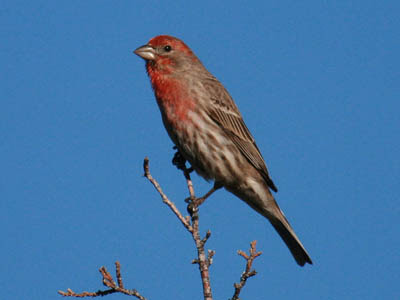 |
| Male House Finch. Greg Gillson. |
Males of this dusty brown striped finch have red limited to the head (specifically the forehead and eyebrow), breast (chest), and rump. The red coloration tends toward orangish, and may rarely be yellowish.
Females are streaked, similar to the males but without red. They lack any strong pattern on the face and head.
Note the small round head and curved upper ridge on the bill.
Some people call these red-headed sparrows. Sparrows and finches are similar, but in general, male finches are brighter than the females and tend to hang out more in trees. Sparrow genders are usually quite similar in coloration and tend to feed mostly on the ground.
These birds are common in residential areas, especially at bird feeders. In the West more widespread in arid regions near water.
House Finches are year-round residents throughout Nevada.
Cassin’s Finch
These red finches are found in ponderosa pine.
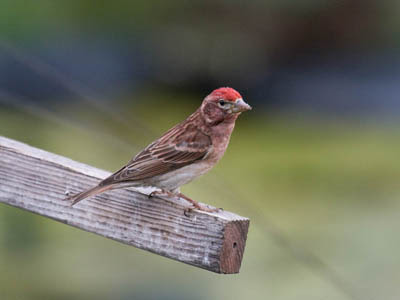 |
| Cassin’s Finch. Greg Gillson. |
Males of these brownish finches are frosted with pink on the upper parts. The crown is the brightest red. They are not streaked on the under parts.
Females lack the red. They have a pale outline of the darker ear patch. Like the males, females are shaped with a large bill that is straight on the upper ridge. The tail is strongly forked.
These finches are found in dry mountain forests of ponderosa pine and juniper. Similar Purple Finches are found in deciduous and wet conifers. House Finches are found in towns everywhere.
Cassin’s Finches will visit feeders within pine forests.
Cassin’s Finches are year-round residents in most of Nevada, absent in southern Nevada.
Anna’s Hummingbird
These are larger hummingbirds with red heads that don’t migrate.
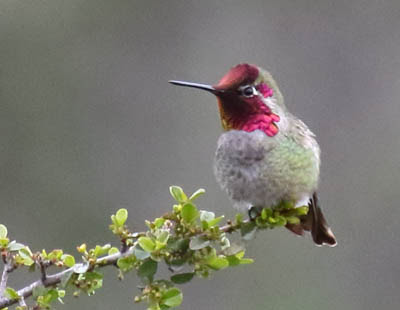 |
| Male Anna’s Hummingbird. Greg Gillson. |
These are big green hummingbirds. Adult males have the entire head red–forecrown and throat, actually. The color of the iridescent feathers is amethyst, a bright reddish purple color, tending towards pink.
Young males have just a spot of red on the center of the throat.
Females lack red, but often show a spot of iridescent green feathers on the center of the white throat. The upper breast is gray. The lower belly and flanks have a greenish tinge. Many other western hummingbird species have cinnamon color under the tail.
They are common in flower gardens and hummingbird feeders year-round.
Anna’s Hummingbirds are year-round residents in southern and southwestern Nevada.
American Robin
These are familiar lawn birds with red breasts.
 |
| American Robin. Greg Gillson. |
Male American Robins are brownish-gray above with a brick red breast. Females are paler orange below and paler gray above.
They are widespread in open country with scattered deciduous trees, residential areas.
American Robins are year-round residents throughout most of Nevada, winter visitors only in southernmost Nevada.
Orange birds of Nevada
True orange-colored birds are not that common. Many birds that I have here are paler rusty.
The common pattern is an orange body and black or brown wings and tail. Another common pattern is for the orange to be restricted to the under parts.
The following are orange birds that you are most likely to see in Nevada.
Cinnamon Teal
What an unusually colored brownish-orange duck!
 |
| Male Cinnamon Teal. Greg Gillson. |
Males are dark cinnamon orange. The wing patches are blue, green, and white. The eye is red.
Females are more mottled brown with matching wing patches.
These birds are found in ponds and grass-lined ditches.
Cinnamon Teals are summer residents throughout Nevada.
Northern Flicker
These unusual woodpeckers with orange under wings are just as likely to be found hopping on your lawn eating ants as they are to be calling from a dead tree top.
 |
| Northern Flicker. Greg Gillson. |
Where is the orange color?
Wait for it…
 |
| Northern Flicker. Greg Gillson. |
The shafts and undersides of the wing and tail feathers are a salmon orange color. A large white rump patch also attracts attention as these birds fly away.
Northern Flickers live in open woods, residential areas. Sometimes visit feeders in winter.
Northern Flickers are year-round residents throughout Nevada.
American Kestrel
These are the familiar small rusty-orange falcons sitting on power lines on the edge of the highway, or hunting and hovering over the median strip.
 |
| Female American Kestrel. Greg Gillson. |
Females are rusty orange barred with black on their back wings and tail. The under parts are buff with black spots. The head shows two facial stripes.
Males have blue-gray backs and rufous tail is unmarked except for black tail band.
These birds are found in open country, farms, pastures with perches.
American Kestrels are year-round residents throughout Nevada.
Ruddy Duck
These small ducks are dark rusty-orange in spring.
 |
| Ruddy Duck. Greg Gillson. |
Males in breeding plumage (late winter and spring) are rusty, with a white face, and a blue bill. The long tail is often held sticking up. In winter they are brown, with white face, and dark bill.
Females all year are like winter males. Brown body, dark cap, dark line through eye of pale face. Dark bill.
These birds prefer weedy ponds to breed, but in winter may be found in deeper ponds in city parks.
Ruddy Ducks are year-round residents in parts of Nevada, winter visitors in northern Nevada, and summer residents in parts of southern Nevada. They are absent in much of south-central Nevada.
Spotted Towhee
These big sparrows with red sides superficially resemble the coloration of robins.
 |
| Spotted Towhee. Greg Gillson. |
These birds have dark hoods and upper parts with rusty rufous-red sides and white bellies. They have white spots over their wings, shoulders, and on their tail corners. The upper parts of the males are jet black, females dark brown. Some populations have paler orange sides.
These are somewhat shy birds that hide in the dense brush and spend most of their time on the ground. They visit feeders during quiet periods.
Spotted Towhees are year-round residents throughout most of Nevada.
Barn Swallow
These orange-bellied birds are a familiar sight across North America in summer.
 |
| Barn Swallow. Greg Gillson. |
These birds are purple-blue above with orange under parts and long forked tails. The color of the underparts in winter or on females are often cinnamon or buff-colored, but breeding males can be brighter orange-red.
These birds swoop low over fields and wetlands at lower elevations. They may build their mud nests in rafters on porches, garages, or other out-buildings.
Barn Swallows are summer residents throughout most of Nevada.
Bullock’s Oriole
These bright orange and black birds are often seen in tall trees.
 |
| Male Bullock’s Oriole. Greg Gillson. |
The males of this species are very bright orange. The back and top of the heads are black. The black wings have large white wing patches. The tail is black with orange sides. The face is orange with a black line through the eye and a black throat.
Females and young are gray with yellow head and breast and tail.
These birds are more common in drier inland regions along watercourses in tall cottonwoods or shade trees. Rarely come to feeders for fruit or nectar in spring.
Bullock’s Orioles are summer residents throughout Nevada.
Black-headed Grosbeak
If you didn’t look closely at these big-billed birds, you might mistake these orange-breasted songsters for American Robins–their coloration and song are very similar!
 |
| Male Black-headed Grosbeak. Greg Gillson. |
Males have black and white wings and tail. Huge bill. The under parts are burnt orange, fading to yellow-orange mid-belly.
Females and first year birds have a striped heads and are brown above, pale buff or butterscotch-orange below.
These birds are found in deciduous or mixed woods. Visit bird feeders.
Black-headed Grosbeaks are summer residents throughout most of Nevada.
Yellow birds of Nevada
Yellow is a common bird color! Often it is mixed with black and white plumage in birds.
Many birds with darker upper parts have yellow breast or belly.
The following are yellow birds you are most likely to see in Nevada.
Lesser Goldfinch
Lesser Goldfinches maintain their bright yellow plumage all year–even in the winter when American Goldfinches are rather brown and colorless.
 |
| Male Lesser Goldfinch. Greg Gillson. |
These tiny birds are bright yellow below (including under the tail), and green or black on the back. The wings and tail are black and white. Males have a black cap, which the females lack.
These birds are found near water in arid regions of the West and Southwest. They are common in residential areas, too, and come to bird feeders.
Lesser Goldfinches are summer residents throughout Nevada, year-round residents in southernmost Nevada.
American Goldfinch
These small little birds are bright yellow and black.
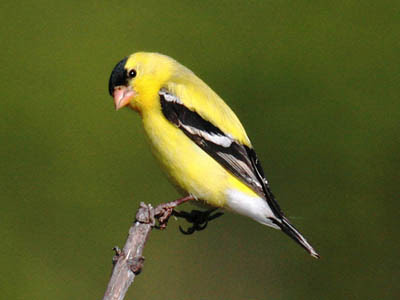 |
| American Goldfinch. Greg Gillson. |
Males are bright lemon yellow with black and white wings and tail, black cap. White under tail coverts. Pink bill.
Females are duller yellow below and brownish above. Lack black cap.
Winter birds are pale brown or gray, a touch of yellow on the throat of males.
These are birds of open country, fields with saplings, clear cuts, residential areas. They avoid dense forests, mountains, deserts. They visit feeders.
American Goldfinches are year-round residents in northern Nevada, winter visitors only in southern Nevada.
Verdin
These are like desert chickadees, but with yellow heads!
 |
| Verdin. Greg Gillson. |
Gray throughout. Adults have yellow head.
Found in thorny desert shrubs, residential areas.
Verdins are year-round residents in southern Nevada.
Yellow-rumped Warbler
These are abundant warblers across North America. Affectionately called “butter butts” by many birders, because of their bright yellow rumps that flash in flight.
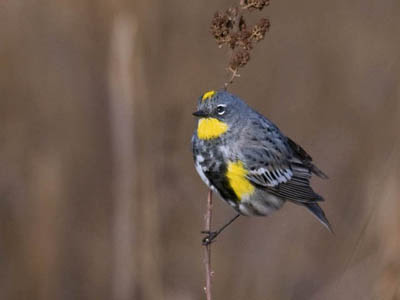 |
| Male Audubon’s Yellow-rumped Warbler. Greg Gillson. |
Western form (Audubon’s) with bright yellow throat and yellow rump. Large white wing patch.
Northern and Eastern form (Myrtle) with white throat, yellow rump, and two white wing bars.
Winter birds are dull gray brown, with bright yellow rump. Throat may be cream colored or white. Often difficult to tell the two forms apart in winter.
 |
| Winter Yellow-rumped Warbler. Greg Gillson. |
Breed in mountain or boreal conifers. Widespread in migration. Winter in low river bottoms, open weedy deciduous areas. Rarely come to feeders in winter.
Yellow-rumped Warblers are year-round residents in southern Nevada, summer residents in northern Nevada.
Western Kingbird
These yellow-bellied birds of the prairies often perch on power lines and fence lines.
 |
| Western Kingbird. Greg Gillson. |
These birds are pale gray on the head and breast. Brown wings. The belly is lemon yellow. Black tail has white outer tail feathers, especially obvious in flight.
These are birds of prairies, deserts, pastures, often near water.
Western Kingbirds are summer residents throughout Nevada.
Western Meadowlark
These are streaky camouflaged prairie birds from above or from behind. But from the front, the breast is shocking yellow!
 |
| Western Meadowlark. Greg Gillson. |
They are streaked brown, black, and gray on the upper parts. The underparts are golden yellow with a black necklace crossing the upper breast. Much paler yellow in fall and winter, as the yellow feathers are tipped with white and streaked with brown.
These are birds of pastures and grasslands and arid regions.
Western Meadowlarks are year-round residents throughout Nevada.
Yellow Warbler
The golden yellow sun packed all into one little bird! Appears to be an all-yellow bird.
 |
| Yellow Warbler. Greg Gillson. |
Some populations are bright yellow, some tend toward greenish on upper parts, some more golden. Yellow internal tail corners in flight.
Males with red breast streaking, again, variable by population.
Females somewhat to much paler yellow, some greenish, some whitish. Lack red streaks.
These birds are found in willow thickets on the edge of wetlands and ditches, stream sides in arid regions.
Yellow Warblers are summer residents throughout most of Nevada, spring and fall migrants only in southwestern Nevada.
Yellow-headed Blackbird
These blackbirds with yellow heads are found in marshes in the West.
 |
| Yellow-headed Blackbird. Greg Gillson. |
Males are glossy black with bright golden-yellow head and breast. White wing patches.
Females are duller brown with mottled yellow breast.
These birds nest in cattail marshes in prairies. Winter in large flocks in agricultural areas.
Yellow-headed Blackbirds are summer residents throughout most of Nevada.
Western Tanager
Numbers of these bright black and yellow birds may show up overnight in backyards in spring migration. Then they disappear the next night.
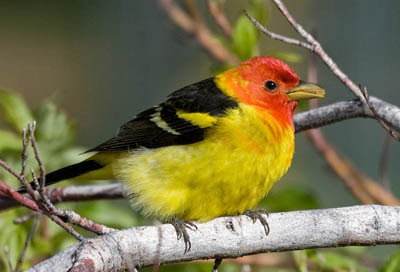 |
| Western Tanager. Greg Gillson. |
Males are brilliant golden yellow with black back, wings, and tail, and a red or orange face. Swollen yellow bill.
Females are more green or gray, with darker wings and tail. Lack red face.
They are found in a variety of wooded habitats, usually conifers or mixed conifer woods, and residential areas with large trees, including mature conifers. Usually don’t visit feeders.
Western Tanagers are summer residents in southern and western Nevada, absent in much of northern Nevada.
Common Yellowthroat
These buttery yellow birds are abundant in the marsh vegetation.
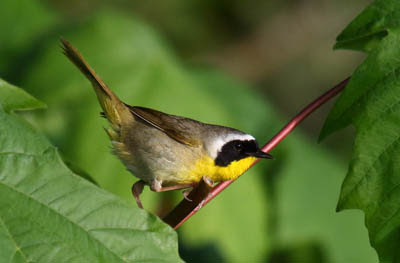 |
| Male Common Yellowthroat. Greg Gillson. |
These skulkers have bright yellow throats and yellow undertail coverts. Males have a black domino mask edged broadly in white, which females lack. Upperparts are dull olive-green.
Immature males in fall show a shadowed black mask.
Found in damp situations and heavy deciduous brambles following clear cuts.
Common Yellowthroats are summer residents in northern Nevada, spring and fall migrants only in southwestern Nevada.
Wilson’s Warbler
These bright yellow birds are very common, both on their summer territories and in migration.
 |
| Male Wilson’s Warbler. Greg Gillson. |
These birds are bright yellow in the West, more greenish above in the East. Only males have the black cap.
Both genders have a beady black eye in the middle of the yellow face.
These birds live in damp understory, tangles, willows.
Wilson’s Warblers are spring and fall migrants throughout Nevada.
MacGillivray’s Warbler
These are yellow-bellied birds of brushy clear cuts.
 |
| MacGillivray’s Warbler. Greg Gillson. |
These ground-loving birds have gray hoods with white eye arcs. Rest of upper parts green. Breast, belly, under tail bright yellow.
Females have slightly paler gray hood, but are otherwise similar to males.
These birds love brushy clear cuts, tangles, thick cover. They stay low.
MacGillivray’s Warblers are summer residents in northern Nevada, spring and fall migrants throughout.
Pine Siskin
These small brown-streaked birds are relatives of the goldfinches. But you would never know it until they fly and sport yellow wing stripes and tail base. Usually in flocks.
 |
| Pine Siskin. Greg Gillson. |
These birds are streaked brown. In flight they have a yellow stripe down the length of the wing. The sides of the base of the tail is also yellow. Some birds are paler, some darker, others brighter yellow, others duller.
These birds are found in summer in northern conifer woods. Irregularly irrupt hundreds of miles southward. Frequent at feeders.
Pine Siskins are year-round residents throughout most of Nevada.
Cedar Waxwing
These crested birds with yellow band on the end of the tail are often found in flocks. They eat flying insects in summer, fruit and berries the rest of the year.
 |
| Cedar Waxwing. Greg Gillson. |
These birds are fawn-brown above, with dark gray wings and tail. They have a black mask and wispy crest. The belly is yellow. The wings have waxy red drops on the end of the tertials. The end of the tail has a brilliant yellow tail band.
They are found in open habitats with berries, including juniper woodlands and towns in winter.
Cedar Waxwings are winter visitors throughout Nevada, year-round residents in northwestern Nevada.
Wrapping Up
As well as red, orange and yellow colored birds, Nevada plays host to some incredible blue and green gems. Here are my favorite:
Mountain Bluebird: This stunning cobalt jewel thrives in high mountains and open woodlands with its cheerful song and iridescent plumage
Western Bluebird: Similar to its mountain cousin but found at lower elevations in canyons and pinyon forests
Lazuli Bunting: A vibrant turquoise flash in summer meadows and grasslands
Indigo Bunting: Dazzling blue males with white wing bars frequent desert scrublands
Juniper Titmouse: A lively emerald gem of pinyon woodlands and juniper forests
Western Wood Pewee: This plain but elegant olive bird offers its mournful call from shady canyons and forests
Frequently Asked Questions
What kind of birds are in Nevada with red heads?
Nevada boasts a surprising variety of birds with red heads, ranging from vibrant songbirds to imposing hawks. Here are some prominent feathered friends you might encounter in the Silver State:
- American Redstart (summer resident): Striking black body with a contrasting bright red breast, found in forests and woodlands.
- Western Tanager (summer resident): A dazzling combination of yellow, black, and a vivid red head, inhabiting conifer forests.
- House Finch (common resident): Familiar backyard guest with a rosy red head and chest.
- Northern Cardinal (rare visitor): Bold and charismatic songbird with a bright red crest and bib, occasionally seen in southern Nevada.
- Summer Tanager (rare visitor): Stunning rose-red body with black wings, a potential sight in eastern Nevada during migration.
Where can I find a Ruddy Duck in Nevada?
While Ruddy Ducks aren’t as common in Nevada as in other parts of the country, you can still potentially find them during the winter months in specific locations. Here are some spots where you might have the best chance of spotting these quirky diving ducks:
Western Nevada:
- Pyramid Lake: This large, saline lake attracts various waterfowl, including Ruddy Ducks, especially during fall and winter. Look for them near shorelines or in sheltered coves.
- Carson Lake Wildlife Refuge: This wetland complex near Fallon provides habitat for Ruddy Ducks, along with other ducks, geese, and shorebirds. Check the observation platform or paddle the waterways for sightings.
- Washoe Lake State Park: While not as abundant as in other spots, Ruddy Ducks have been documented at this lake near Reno. Search the open water areas or scan the reeds along the shorelines.
Eastern Nevada:
- Pahranagat National Wildlife Refuge: This refuge along the Amargosa River offers wintering grounds for Ruddy Ducks. Look for them in the quieter backwaters or near the visitor center.
- Spring Valley State Park: While less likely than other locations, there have been records of Ruddy Ducks in the ponds and marshes within the park. Keep an eye out near the visitor center or explore the wetlands by foot.
Southern Nevada:
- Las Vegas Area: Surprisingly, even the urban oasis of Las Vegas can attract Ruddy Ducks! Wetlands Park and Henderson Bird Viewing Preserve offer potential sightings, especially during migration periods.
- Lake Mead National Recreation Area: The vast Lake Mead attracts various waterfowl, and Ruddy Ducks can occasionally be found in sheltered coves or near marinas. Take a boat tour or scan the shorelines from lookout points.
What kind of bird has a yellow belly in Nevada?
Nevada boasts a diverse array of birds, and many of them sport a vibrant yellow belly. Identifying the specific bird depends on additional features like size, shape, plumage, and location. Here are some possibilities:
Songbirds:
- Yellow Warbler (summer resident): This small, active warbler with a bright yellow belly and olive green back frequents riparian areas and willow thickets.
- Cedar Waxwing (resident and migrant): A larger bird with a smooth, sleek look, featuring a yellow belly, gray wings, and a distinctive red “wax wing tip.” Seen in various habitats, including forests, orchards, and even urban areas.
- American Goldfinch (common resident): A charming songbird with a bright yellow body (including the belly) in males during breeding season, turning brown in winter. Found in open fields, grasslands, and gardens.
- Western Tanager (summer resident): A stunning bird with a black head and throat, bright yellow belly, and red wings, inhabiting coniferous forests and mountain meadows.
Woodpeckers:
- Northern Flicker (common resident): This large woodpecker has a yellow belly with black bars, a distinctive black bib, and a long, curved bill. Seen in various habitats, including forests, parks, and even backyards.
- Gilded Flicker (resident in southern Nevada): Similar to the Northern Flicker but with a more golden yellow belly and a red nape. Found in arid woodlands and deserts.
Related Articles:
See photos and learn about the most common backyard birds in Nevada, regardless of color.
Here’s a quick tutorial of how I would teach you to identify birds: 7 Steps to Identify Birds!
Birds with red heads in North America.
Yellow-and-black birds in North America.










